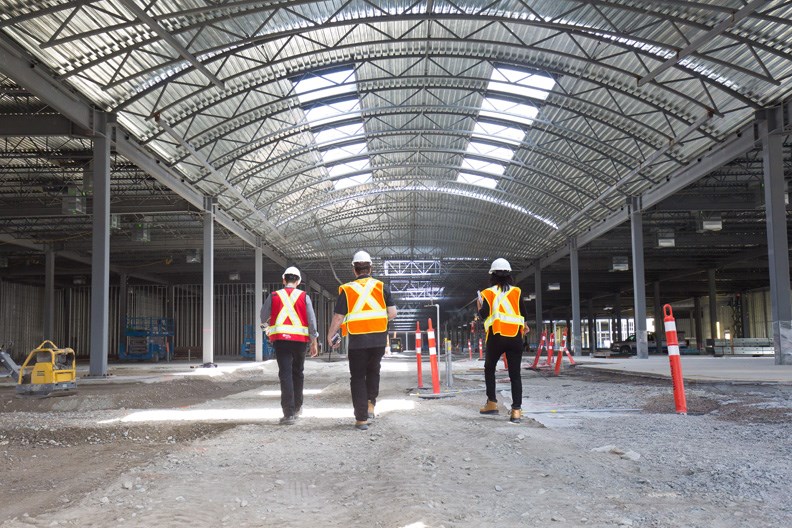The Tsawwassen First Nation's transformation is well underway.
Six years after its historic urban treaty was ratified, other Lower Mainland municipalities, including neighbouring Delta, are witness to several major development projects at the 725-hectare (over 1,800-acre) First Nation, moving it closer to becoming a real economic powerhouse in the region.
"The new projects that we're building, partnerships that were forging, are developing new sources of revenue, and building new infrastructure and will create many new jobs," says Chief Bryce Williams. "Most importantly, these projects promise a bright future for our children and our children's children. The opportunities they'll have to live and work and learn on Tsawwassen lands is the reason we're undertaking this work. It's really cool to be here at this moment in time and establish what needs to be in place for our children and their future," Williams says.
Although they've been making most of the news coming out of the busy Tsawwassen lands lately, it's not all just about Tsawwassen Mills and Tsawwassen Commons, the mega shopping malls now under construction. Having a combined size rivaling Burnaby's Metrotown, the two centres are set to change the face of Lower Mainland retail when they open next fall.
Next door, construction is steadily underway on housing developments that will eventually see over 2,200 new homes.
Having already sold out its first couple of phases, Aquilini Development's Tsawwassen Shores, a partnership with the fee simple property holders, is a development that will comprise 850 of those units, which will include single-family homes, townhomes and condos.
The number of TFN members living on Tsawwassen lands, which is no longer referred to as "a reserve," stands at around 200. That's roughly half the total TFN membership, with the other half living elsewhere. Metro Vancouver's long-term regional growth strategy forecasts the overall population to grow to more than 8,500 people. The new housing, by the way, will include units for TFN members.
Already the first B.C. First Nation to have a seat in regional government as a member of Metro Vancouver, the TFN and its economic development corporation are keen to develop several hundred acres of industrially-zoned lands, including a logistics centre ideally situated near the ports at Roberts Bank.
Having been named a finalist for this year's provincial Open for Business Awards, which recognizes municipalities and First Nations that undertake initiatives to reduce the cost and complexity of doing business, the TFN has 135 hectares (335 acres) designated for industrial development.
The First Nation is advertising the property will "appeal to tenants of all types and sizes seeking to take advantage of a large industrial park that can provide state of the art intermodal, goods handling, light manufacturing, warehousing and distribution services." One of the projects in the industrial area will be a Chevron cardlock truck fueling centre, which will open this fall.
Another is a container examination facility in partnership with Port Metro Vancouver, set to open in 2017.
The container inspection facility will be a huge purposebuilt facility costing in excess of $10 million. It will signifi cantly help improve the flow of containers, especially since border security officials now have to send containers to an inspection facility in Burnaby.
"It's going to reduce the amount of truck traffic in the Lower Mainland," said Port Metro Vancouver president and CEO Robin Silvester. "It's a state-of-the-art facility and will have the latest technology for inspecting containers, and it's going help CBSA (Canada Border Services Agency) ensure the security of the container trade that's really important to all of us."
Meanwhile, construction has begun on the first phase of a 24-hectare (60-acre) logistics warehouse development, a partnership with Great West Life Realty Advisors Inc.
A number of major road projects are also underway in and around the TFN to accommodate the growth, including new roadways that will create direct connectivity from the provincial highway into the industrial areas and port.
To help service all that development, the federal government this summer announced funding for a significant upgrade to a regional water main in order to service the TFN within Metro Vancouver. The federal and provincial governments will contribute $3.7 million each while the Greater Vancouver Water District has already committed $4.6 million. The TFN will pick up the remainder of the cost, estimated to be around $17.6 million
Work is already underway on a $25 million sanitary sewer treatment plant.
The provincial government announced this month the Tsawwassen First Nation will receive $440,000 in BikeBC funding for a new multi-use path for cyclists and pedestrians, linking the First Nation with the B.C. Ferries terminal, thus creating additional tourism opportunities. The TFN is also building a new sports field complex for its members to open later this year, a project Williams said has been needed for years. A second phase, which includes such amenities as lacrosse boxes, is planned for next year. The young chief says they are also planning to construct a new government building that will feature a health centre as well as an elders' centre.
"We're growing every year and outgrowing our spaces right now," he says.
The TFN still has roughly 217 hectares (540 acres) designated as agricultural. Farming is taking place there along with the new Tsawwassen First Nation Farm School, a collaboration between the TFN and the Institute for Sustainable Food Systems at Kwantlen Polytechnic University.



